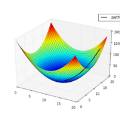This paper presents two computationally efficient algorithms for the orientation estimation of inertial measurement units (IMUs): the correntropy-based gradient descent (CGD) and the correntropy-based decoupled orientation estimation (CDOE). Traditional methods, such as gradient descent (GD) and decoupled orientation estimation (DOE), rely on the mean squared error (MSE) criterion, making them vulnerable to external acceleration and magnetic interference. To address this issue, we demonstrate that the multi-kernel correntropy loss (MKCL) is an optimal objective function for maximum likelihood estimation (MLE) when the noise follows a type of heavy-tailed distribution. In certain situations, the estimation error of the MKCL is bounded even in the presence of arbitrarily large outliers. By replacing the standard MSE cost function with MKCL, we develop the CGD and CDOE algorithms. We evaluate the effectiveness of our proposed methods by comparing them with existing algorithms in various situations. Experimental results indicate that our proposed methods (CGD and CDOE) outperform their conventional counterparts (GD and DOE), especially when faced with external acceleration and magnetic disturbances. Furthermore, the new algorithms demonstrate significantly lower computational complexity than Kalman filter-based approaches, making them suitable for applications with low-cost microprocessors.
翻译:本文提出了两种计算效率较高的算法,用于惯性测量单元(IMU)的方向估计:基于依据均方差矫正的梯度下降(CGD)和基于依据均方差矫正的分解定向估计(CDOE)。传统的方法,如梯度下降(GD)和分解定向估计(DOE),依赖于均方误差(MSE)准则,使其容易受到外部加速度和磁干扰的影响。为了解决这个问题,我们证明了多核心依据均方差矫正损失(MKCL)在噪声遵循某种重尾分布时是最优的最大似然估计(MLE)的目标函数。在某些情况下,即使在存在任意大的异常值的情况下,MKCL 的估计误差也被限定在一定范围内。通过用 MKCL 替换标准的 MSE 成本函数,我们开发了 CGD 和 CDOE 算法。我们通过在各种情况下比较它们与现有算法的有效性来评估我们提出的方法。实验结果表明,我们提出的方法(CGD 和 CDOE)优于其传统对应物(GD 和 DOE),特别是在面对外部加速度和磁干扰时。此外,新算法比基于 Kalman 滤波器的方法具有显着较低的计算复杂度,使其适用于低成本微处理器的应用。





